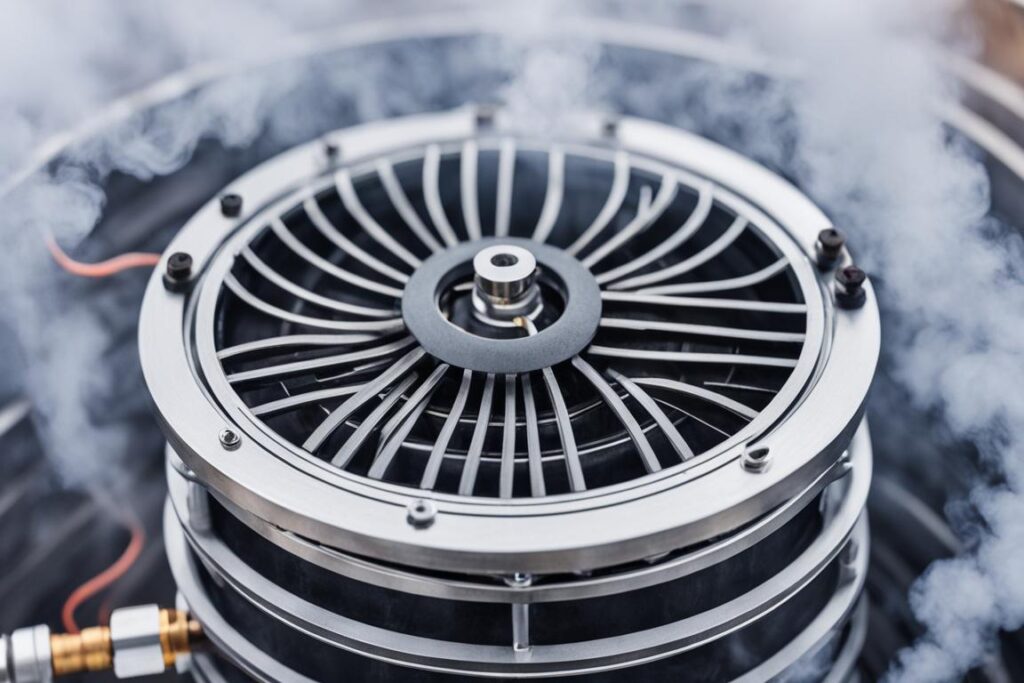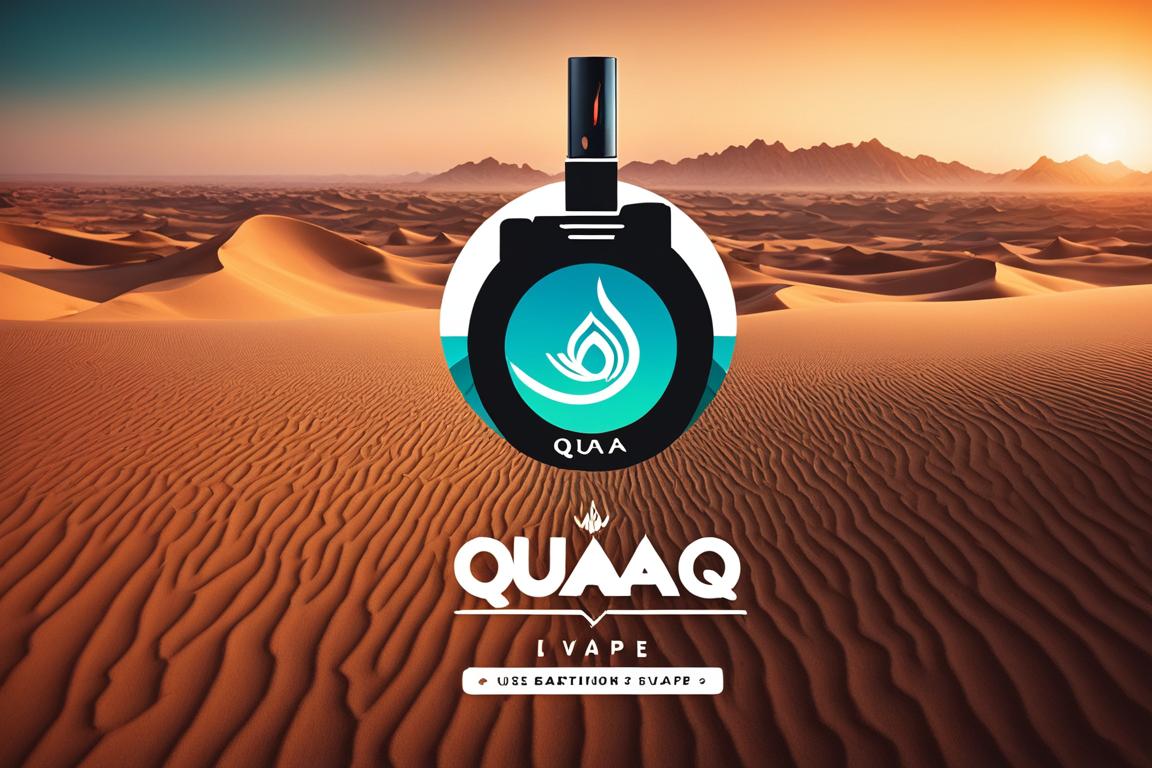Welcome to our essential guide for UAE users on understanding quaq in a vape. If you’re new to vaping or curious about this popular alternative to smoking, you’ve come to the right place. In this guide, we’ll cover everything you need to know about vaping and the concept of quaq.
Vaping involves inhaling water vapor through a personal vaporizer, providing a nicotine hit without the adverse effects of traditional cigarettes. But what exactly is quaq? Let’s dive in and find out!
Table of Contents
ToggleKey Takeaways:
- Vaping is an alternative to smoking, involving inhaling water vapor through a personal vaporizer.
- Quaq is a concept within the world of vaping that we will explore in this guide.
- This guide aims to provide UAE users with essential information on vaping and quaq.
- We will cover the history of vaping, the anatomy of a vaporizer, what vaping is like, where you can vape, the benefits and potential health effects of vaping, and more.
- Stay informed and make informed choices to navigate through the misconceptions surrounding vaping.
The History of Vaping
Vaping, a popular alternative to smoking, has a rich history that dates back to the 1960s. It all began with the invention of the first vaporizer by Hon Lik, a Chinese pharmacist.
“Ruyan,” meaning “like smoke” in Chinese, was the groundbreaking vaporizer created by Hon Lik. His inspiration behind this invention was the loss of his father to smoking-related cancer.”
The Ruyan vaporizer gained traction in the mid-2000s, marking the birth of the vaping industry. Hon Lik’s invention revolutionized the way people approached nicotine consumption and offered a potentially safer alternative to traditional cigarettes.
The Rise of Hon Lik and Ruyan
Hon Lik’s personal experience with the consequences of smoking fueled his determination to create a device that could deliver nicotine without the harmful chemicals associated with combustible cigarettes. The development of Ruyan was an important milestone in this pursuit, as it paved the way for the modern vaping devices we see today.
With its innovative design, Ruyan attracted a significant following and demonstrated the demand for smoke-free alternatives. Its success not only laid the foundation for the vaping industry but also inspired countless other inventors and entrepreneurs to explore the possibilities of this emerging market.
Since then, vaping has continued to evolve, offering a wide range of devices, flavors, and options for users to enjoy. As technology advances and public awareness grows, the vaping industry remains dynamic and ever-changing.
Continue reading to learn more about the components of a vaporizer, the experience of vaping, and the potential benefits and drawbacks of this alternative to smoking.
Anatomy of a Vaporizer
A vaporizer is a sophisticated device that consists of several essential components, each playing a crucial role in delivering a satisfying vaping experience. Understanding the anatomy of a vaporizer is important for both new and experienced vapers. Let’s take a closer look at these key components:
The Battery
The battery is the powerhouse of the vaporizer, providing the necessary electrical energy to heat the e-liquid and produce vapor. It is usually rechargeable and comes in different capacities and voltages, offering users the flexibility to choose a battery that suits their vaping needs.
The Tube
The tube, also known as the body or chassis, serves as the main structural component of the vaporizer. It houses the battery, and its shape and design may vary depending on the make and model of the device. The tube also provides protection and insulation for the internal components.
The Cartridge
The cartridge, sometimes referred to as a tank or clearomizer, is where the e-liquid is stored. It typically features a transparent design, allowing vapers to monitor the e-liquid level. Cartridges come in different capacities and can be refillable or disposable, depending on the device.
The Atomizer
The atomizer is responsible for heating the e-liquid and transforming it into vapor. It contains a heating element, often a coil, which is connected to the battery. When activated, the battery heats the coil, which then vaporizes the e-liquid. The atomizer plays a crucial role in the overall vaping experience by determining the flavor and vapor production.
The Cartomizer
A cartomizer is a combination of a cartridge and an atomizer. It simplifies the vaping process by incorporating both components into a single unit. The e-liquid is contained within the cartomizer, and the atomizer is integrated into the bottom, eliminating the need for separate parts. Cartomizers are commonly found in beginner-friendly devices.
E-Liquid Ingredients
The e-liquid, also referred to as e-juice, is the substance that is vaporized and inhaled during vaping. It typically consists of a blend of vegetable glycerine (VG) or propylene glycol (PG), nicotine, and flavorings. VG and PG serve as the base for the e-liquid, while nicotine provides the desired level of satisfaction. Flavorings add an array of tastes and aromas, allowing vapers to customize their vaping experience.
Understanding the role and function of each vaporizer component is crucial for choosing the right device and ensuring an enjoyable vaping experience. Now that we have explored the anatomy of a vaporizer, let’s dive deeper into the vaping process and discover what it is like.

What is Vaping Like?
When indulging in vaping, the experience can vary based on different factors, including the nicotine strength of the e-liquid, also known as vape juice. Nicotine strengths range from ultra-light to strong, allowing vapers to choose their desired intensity.
The nicotine strength directly influences the throat hit, which refers to the sensation felt in the throat when inhaling the vapor. A stronger nicotine strength typically results in a more pronounced throat hit, while a lower strength provides a milder experience.
For those new to vaping, it is recommended to start with a lower nicotine strength and gradually increase it until finding the optimal level that suits individual preferences. This allows for a personalized experience and helps adjust to the throat hit associated with vaping.
Vaping offers a customizable and odorless smoking alternative, allowing users to explore various flavors and nicotine strengths to enhance their vaping experience. With a wide range of options available, vapers can discover their perfect combination of flavors and nicotine strengths to satisfy their cravings.
To gain a better understanding, below is a table showcasing the different nicotine strengths commonly used in the vaping community:
| Nicotine Strength | Description |
|---|---|
| Ultra-Light (0mg or 0%) | No nicotine present |
| Light (3mg or 0.3%) | Low nicotine concentration |
| Moderate (6mg or 0.6%) | Moderate nicotine concentration |
| Medium (12mg or 1.2%) | Medium nicotine concentration |
| Strong (18mg or 1.8%) | High nicotine concentration |
Remember, finding the right nicotine strength and throat hit is a personal journey. Take the time to experiment and find the vaping experience that suits your preferences.
Where Can You Vape?
While vaping is legal in most places, it is essential to be aware of and respect the rules and regulations regarding vaping in public spaces. Vaping restrictions and regulations vary from country to country, and even within different regions of the same country. To ensure a pleasant vaping experience that doesn’t infringe on the rights of others, here are some key points to consider:
1. Know the Laws and Regulations
Before you vape in any public space, familiarize yourself with the specific vaping regulations in that area. Some countries, such as the United Arab Emirates, have implemented vaping restrictions in certain indoor and outdoor locations. It is important to adhere to these laws to avoid any potential legal consequences.
2. Respect No Vaping Zones
Many public spaces, such as airports, government buildings, schools, and hospitals, have designated “no vaping” zones. These areas are meant to protect non-vapers from exposure to secondhand vapor and maintain a comfortable environment for everyone. Always look for signs or ask for guidance to determine where you can and can’t vape.
3. Be Considerate of Others
Even in locations where vaping is allowed, it is crucial to be considerate of those around you. Some people may be sensitive to the smell or presence of vapor. To avoid causing discomfort, try to find a secluded spot or step away from crowds before vaping. Additionally, be mindful of your exhaled vapor to reduce the chances of inadvertently affecting others.
4. Observe Workplace Policies
If you vape at work, make sure to follow your company’s vaping policies. Some workplaces have designated vaping areas or allow vaping only during designated break times. It is essential to respect these policies and maintain a professional atmosphere for both vapers and non-vapers.
5. Dispose of Waste Properly
When vaping outside, it is essential to dispose of any waste responsibly. This includes properly disposing of used e-liquid bottles, cartridges, and batteries in designated recycling bins or containers. By doing so, you not only contribute to a cleaner environment but also help eliminate potential hazards.
6. Follow Airline Regulations
If you plan to vape while traveling, it is crucial to familiarize yourself with airline regulations regarding vaping devices and e-liquids. Most airlines consider vaping devices as part of carry-on luggage and prohibit their use during the flight. Make sure to check the specific guidelines of your airline to avoid any inconvenience.
By being aware of and adhering to vaping restrictions and regulations, you can enjoy vaping responsibly and ensure a harmonious coexistence with non-vapers in public spaces.

| Locations | Vaping Restrictions |
|---|---|
| Restaurants and Cafes | Vaping may be prohibited indoors. |
| Public Parks | Vaping regulations vary. Some parks may allow vaping, while others have designated areas or prohibit it entirely. |
| Public Transportation | Vaping is generally not allowed on buses, trains, or other forms of public transportation. |
| Shopping Malls | Some malls may allow vaping in open areas, while others have designated vaping zones or prohibit it completely. |
| Hotels | Each hotel may have its own policies on vaping. It is best to check with the hotel management before vaping in your room or common areas. |
The Benefits of Vaping
When it comes to vaping, there are several key advantages that make it an appealing choice for those seeking a safer alternative to smoking. Let’s explore the benefits of vaping:
Vaping Safety
Vaping is considered safer than smoking because it eliminates many of the harmful chemicals associated with tobacco combustion. Traditional cigarettes release toxins from burning tobacco, which can lead to various health problems. In contrast, vaping involves heating e-liquids that contain nicotine and other ingredients, producing vapor that is inhaled by the user. This eliminates the risks associated with tar and other harmful substances found in cigarettes.
Harm Reduction
Another benefit of vaping is harm reduction. By switching to vaping, smokers can significantly reduce the harm caused by traditional tobacco products. Vaping provides a similar experience to smoking, including the throat hit, hand-to-mouth action, and the inhalation of vapor. This makes it easier for smokers to transition away from cigarettes and eventually quit smoking altogether. Additionally, vaping allows users to control their nicotine intake by choosing e-liquids with different nicotine strengths, helping them gradually reduce their dependence on nicotine.
Cost-Effectiveness
Vaping can also be more cost-effective in the long run compared to traditional smoking. While the initial investment in a vaporizer and accessories may seem high, it can lead to significant savings over time. Once you have your device, the main ongoing cost is purchasing e-liquids, which can be more affordable than buying packs of cigarettes. With a wide range of e-liquid flavors and brands available, vapers have the flexibility to choose options that suit their preferences and budgets.
| Benefits of Vaping | Explanation |
|---|---|
| Vaping Safety | Vaping eliminates the harmful chemicals associated with tobacco combustion, making it a safer alternative to smoking. |
| Harm Reduction | Vaping helps smokers reduce the harm caused by traditional tobacco products by providing a similar experience without the harmful effects of burning tobacco. |
| Cost-Effectiveness | Vaping can be more cost-effective in the long run compared to smoking, as it eliminates the need for buying packs of cigarettes on a regular basis. |
The Negative Health Effects of Vaping
While vaping is generally considered less harmful than smoking, it is important to be aware of the potential health effects associated with this practice. One of the concerning aspects of vaping is nicotine addiction. Nicotine, a highly addictive substance found in e-liquids, can lead to dependence and withdrawal symptoms, making it difficult for users to quit.
Moreover, studies have shown that vaping can damage blood vessels and have an impact on cardiovascular health. This is concerning as it can increase the risk of heart disease and other cardiovascular conditions. Even without nicotine, the chemicals present in e-liquids can cause inflammation and irritation of the blood vessels, leading to potential long-term damage.
It is crucial to note that vaping devices and e-liquids vary widely in terms of ingredients and quality. The effects on health can depend on factors such as the specific device used, the ingredients in the e-liquid, and the individual’s tolerance to these substances. However, more research is needed to fully understand the long-term effects of vaping and its impact on overall health.
“The potential health effects of vaping are a cause for concern. Nicotine addiction and blood vessel damage are among the most prominent risks associated with this practice. It is essential for vapers to be aware of these potential dangers and make informed choices about their usage.”
Health Risks of Vaping:
- Nicotine addiction
- Dependence and withdrawal symptoms
- Damage to blood vessels
- Increased risk of cardiovascular diseases
In light of these health risks, it is crucial for individuals, especially those who are considering vaping as an alternative to smoking, to weigh the potential benefits against the potential harm. It is advisable to consult with a healthcare professional for personalized guidance and support in making informed decisions about vaping.
| Health Risks | Evidence |
|---|---|
| Nicotine addiction | Highly addictive substance found in e-liquids |
| Dependence and withdrawal symptoms | Inability to quit vaping without experiencing discomfort |
| Damage to blood vessels | Chemicals in e-liquids can cause inflammation and irritation |
| Increased risk of cardiovascular diseases | Impact on heart health and blood vessel function |
Conclusion
Vaping has emerged as a booming industry, offering users a wide array of products and flavors to choose from. While it presents a potential alternative to smoking, it is crucial to understand that vaping is not entirely risk-free. Instead, it should be viewed as a harm reduction tool for individuals seeking to quit smoking.
As vaping continues to gain popularity, it is essential for users to stay informed about the potential risks and misconceptions surrounding it. Research is ongoing to fully comprehend the long-term effects of vaping on health. By staying updated on the latest findings, users can make informed choices that align with their personal goals.
The vaping industry provides smokers with a customizable and odorless alternative to traditional cigarettes. However, it is important to approach vaping with caution, recognizing that it is not without its potential health consequences. By understanding the importance of harm reduction and keeping up with the latest research, users can navigate through any misconceptions surrounding vaping and make well-informed decisions about their smoking habits.
FAQ
What is vaping?
Vaping refers to the act of inhaling water vapor through a personal vaporizer, which is an alternative to smoking traditional cigarettes. It involves heating a liquid to generate vapor that is then inhaled by the user.
Who invented vaping?
Vaping was invented by Hon Lik, a Chinese pharmacist, in the 1960s. Lik created the first vaporizer called Ruyan, which gained popularity in the mid-2000s and marked the birth of the vaping industry.
What are the components of a vaporizer?
A vaporizer consists of a battery, a tube, a cartridge, an atomizer, and a cartomizer. The e-liquid, which contains ingredients such as nicotine, flavoring, and vegetable glycerin or propylene glycol, is housed in the cartridge and vaporized by the atomizer.
What is the nicotine strength in e-liquids?
E-liquids come in different nicotine strengths, ranging from ultra-light to strong. The nicotine strength determines the throat hit or sensation experienced by the user. It is advisable to start with a low nicotine strength and gradually increase to find the optimal level.
Where can you vape?
While vaping is generally legal, there may be restrictions on where you can use your vaporizer. It is important to be aware of and respect the rules and regulations regarding vaping in public spaces. Vapers should follow any designated vaping areas or restrictions.
What are the benefits of vaping?
Vaping is considered less harmful than smoking as it eliminates tobacco and combustion. It provides a customizable and odorless smoking alternative, saves money in the long run, and reduces the need for ash and cigarette butts.
What are the negative health effects of vaping?
While vaping is generally considered less harmful than smoking, it is not without its potential health effects. Nicotine, found in e-liquids, can lead to dependence and withdrawal symptoms. Vaping, even without nicotine, can also damage blood vessels and impact cardiovascular health.
What is the conclusion on vaping?
Vaping is a rapidly growing industry that offers a potentially less harmful alternative to smoking. However, it is important to be aware of the potential risks and make informed choices. Vaping should be seen as a harm reduction tool and not a completely safe activity. Stay updated on the latest research and navigate through the misconceptions surrounding vaping.

